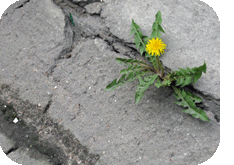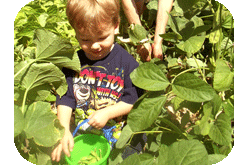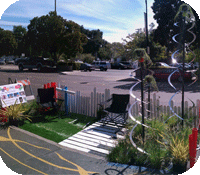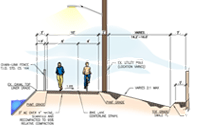What's in a Weed? The Modern Trend of Urban Foraging
Author: Chad Kennedy, Landscape Architect, ASLA
 The youngest boy scout, avid hikers, and just about anyone who enjoys outdoor recreation has a story to tell about an unpleasant encounter with patches of annoying and sometimes painful stinging nettle. Despite hikers best attempts to avoid them, nettle patches seemingly follow hikers, antagonizing them as they make their way along trails and through meadows and thickets. It is intriguing and ironic that, despite stinging nettle's reputation in the natural environment, in many urban environments it is sought after and highly valued? Granted this statement sounds odd, but there is actually a growing trend in many U.S. cities of harvesting and using urban plants and weeds (like stinging nettle and other plants considered to be weeds) as food sources, as homeopathic medicinal remedies and even as materials for soaps, arts and crafts.
The youngest boy scout, avid hikers, and just about anyone who enjoys outdoor recreation has a story to tell about an unpleasant encounter with patches of annoying and sometimes painful stinging nettle. Despite hikers best attempts to avoid them, nettle patches seemingly follow hikers, antagonizing them as they make their way along trails and through meadows and thickets. It is intriguing and ironic that, despite stinging nettle's reputation in the natural environment, in many urban environments it is sought after and highly valued? Granted this statement sounds odd, but there is actually a growing trend in many U.S. cities of harvesting and using urban plants and weeds (like stinging nettle and other plants considered to be weeds) as food sources, as homeopathic medicinal remedies and even as materials for soaps, arts and crafts.
Food Source: The idea of growing food in urban environments is not all that unique of an idea. Urban and suburban families have grown vegetables in back yard gardens, vacant lots and window boxes for generations. A new urban agricultural trend has begun to emerge, however; in many U.S. Cities groups of "foragers", including professional foragers, scour the urban environment in search of useful and edible plants. Foragers find these plants growing between the cracks in concrete, in parks, in urban landscapes and in vacant abandoned lots. Some even grow and maintain their own urban gardens throughout the City. Intentions differ as some foragers are seeking to supplement their own diets, while others supply trendy restaurants with greens, roots and flowers from common plants that are not commonly used in American diets. Some groups of foragers are reported to pick a variety of over 400 plant species throughout the year.3 Many of these plant species are considered weeds to the majority of the population, however, they can be very nutritious and when prepared correctly, at the right time of year, can be a fresh change to any diet. Along the American River in Sacramento, CA blackberries are a commonly harvested fruit, as are the ever popular figs, kumquats and plums in the region. Other commonly harvested edible plants in urban cities throughout the U.S. include purslane, fiddlehead fern, walnuts, wild mushrooms, dandelions, mustards, plantain, stinging nettle, Japanese knotweed, crab apples, wild mint, lemony sorrel, chickweed, ground ivy, lambs quarters, wild garlic and dead nettle. 1234
There is in fact enough demand for these plants that companies have formed which employ foragers whose job it is to find and provide un-commonly used plants for restaurants. In the New York region one such company provides weedy plants for use in dishes at a three star New York City Restaurant.1 There are also recipe books available on-line, such as Tama Matsuoka Wong's Foraged Flavor, to help guide those brave enough to find, harvest and cook their own local weeds and foraged plants.

Medicinal Value
: The historic use of plants for medicinal properties is no secret and is well documented. What is interesting, however, is that the practice of harvesting and using these plants is still alive and well within our modern urban environments. Stinging nettle is often foraged to make teas and topical poultices helpful in treating arthritis and pain.4 Yellow dock can be used as an anti-irritant and is applied to the skin, which is especially helpful for those who are a bit careless while harvesting nearby stinging nettle! Willow buds and the bark from some species of trees are also harvested by foragers for their antimicrobial, anti-inflammatory and antioxidant properties.4
Arts and Crafts: In addition to weeds and plants prized for their taste, nutritional or medicinal value, there are plants in urban environments used more for their value in arts and crafts. A few examples of these are willow branches, which are often foraged for basket and wreath weaving activities, ivy and other plants used in flower arrangements and evergreen bows and cones collected during the holidays to create ornaments and other decorations.4
Who would have thought that a crack in the sidewalk, an overgrown vacant lot, or a public park could support a vibrant urban agricultural society,or does it? I guess it all depends on how you view the weed patch -- like an aggravated hiker stuck in a patch of nettle or a giddy forager surrounded by gold.
 The youngest boy scout, avid hikers, and just about anyone who enjoys outdoor recreation has a story to tell about an unpleasant encounter with patches of annoying and sometimes painful stinging nettle. Despite hikers best attempts to avoid them, nettle patches seemingly follow hikers, antagonizing them as they make their way along trails and through meadows and thickets. It is intriguing and ironic that, despite stinging nettle's reputation in the natural environment, in many urban environments it is sought after and highly valued? Granted this statement sounds odd, but there is actually a growing trend in many U.S. cities of harvesting and using urban plants and weeds (like stinging nettle and other plants considered to be weeds) as food sources, as homeopathic medicinal remedies and even as materials for soaps, arts and crafts.
The youngest boy scout, avid hikers, and just about anyone who enjoys outdoor recreation has a story to tell about an unpleasant encounter with patches of annoying and sometimes painful stinging nettle. Despite hikers best attempts to avoid them, nettle patches seemingly follow hikers, antagonizing them as they make their way along trails and through meadows and thickets. It is intriguing and ironic that, despite stinging nettle's reputation in the natural environment, in many urban environments it is sought after and highly valued? Granted this statement sounds odd, but there is actually a growing trend in many U.S. cities of harvesting and using urban plants and weeds (like stinging nettle and other plants considered to be weeds) as food sources, as homeopathic medicinal remedies and even as materials for soaps, arts and crafts. 

 The O'Dell Engineering team has been hard at work preparing conceptual plans for the next section of the City of Ceres' Main Canal Bike Path project. The conceptual plans show the proposed alignment, safety lighting and improvement features for a nearly 2.5 mile stretch of the bike path which runs along a utility and canal corridor. The next step in the process is preparation of construction documents for phase 1 of the project.
The O'Dell Engineering team has been hard at work preparing conceptual plans for the next section of the City of Ceres' Main Canal Bike Path project. The conceptual plans show the proposed alignment, safety lighting and improvement features for a nearly 2.5 mile stretch of the bike path which runs along a utility and canal corridor. The next step in the process is preparation of construction documents for phase 1 of the project.